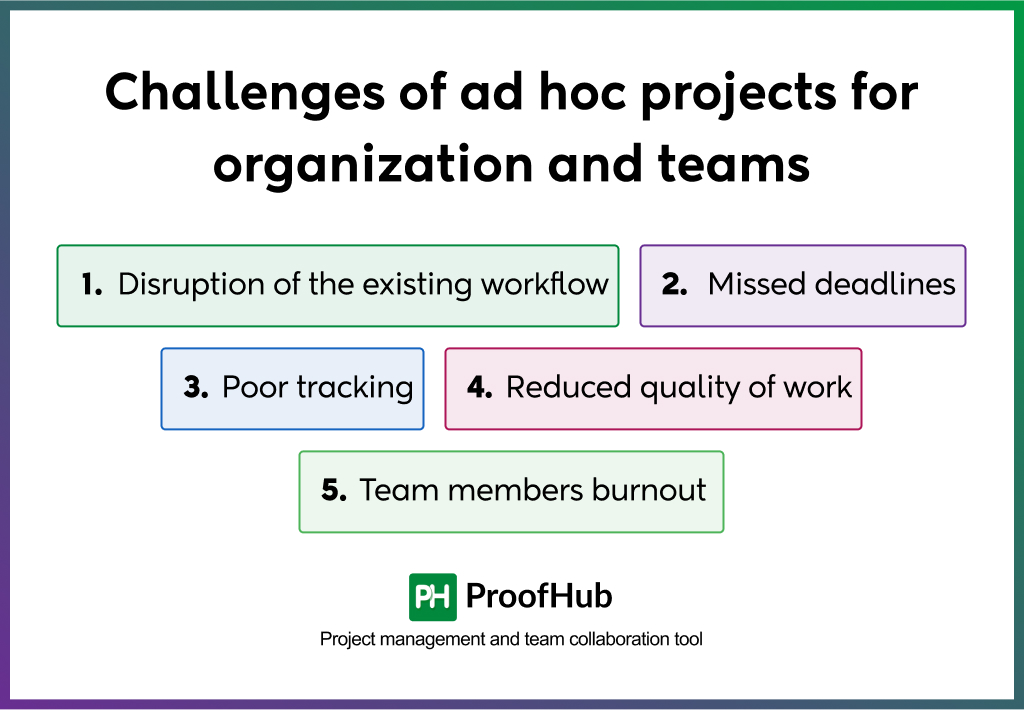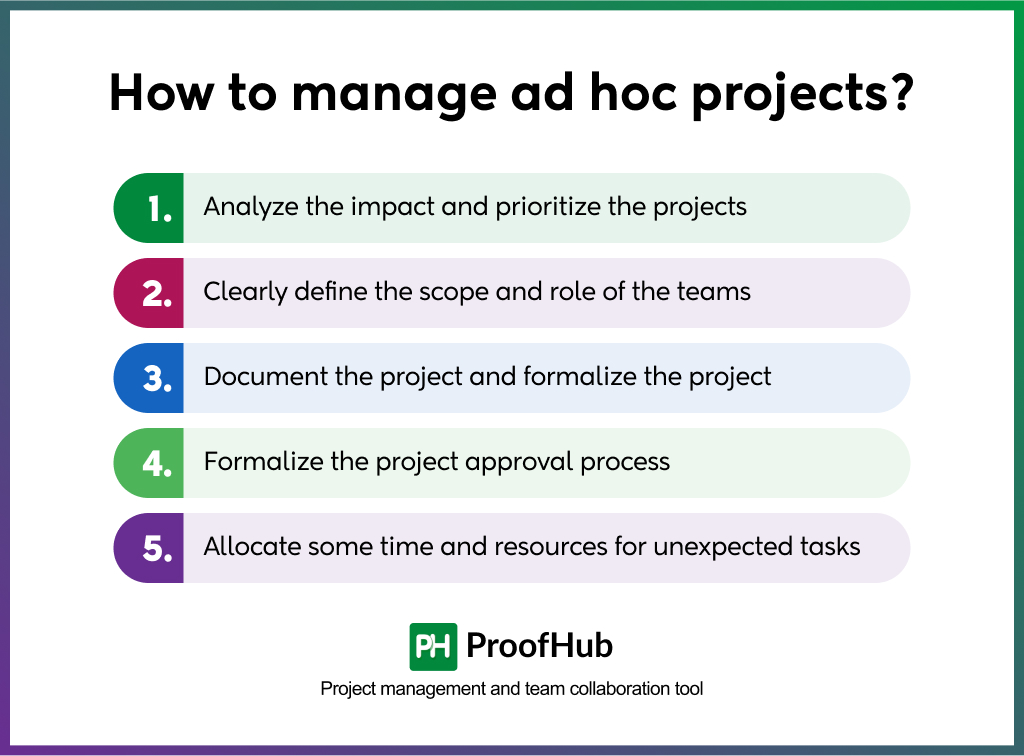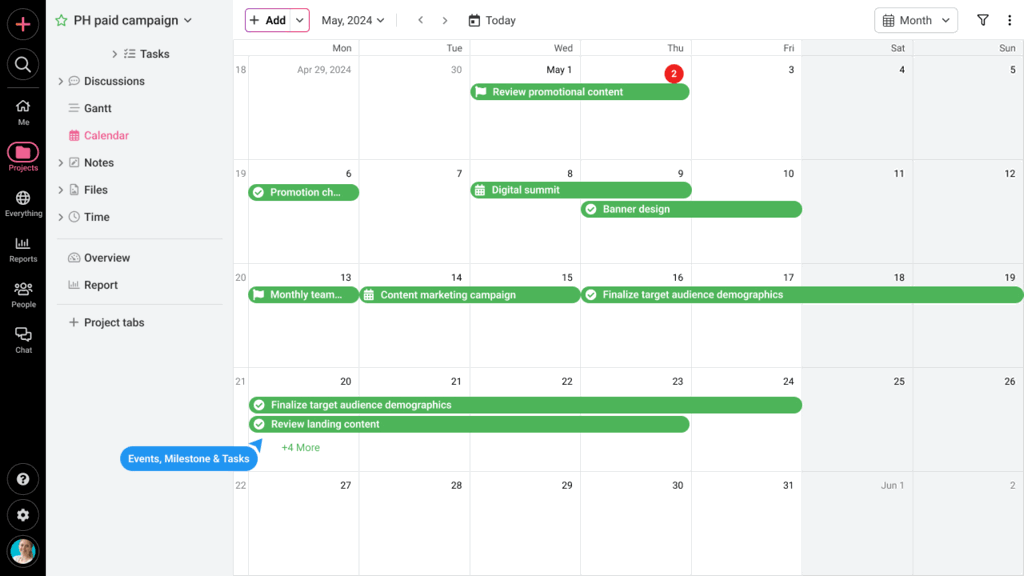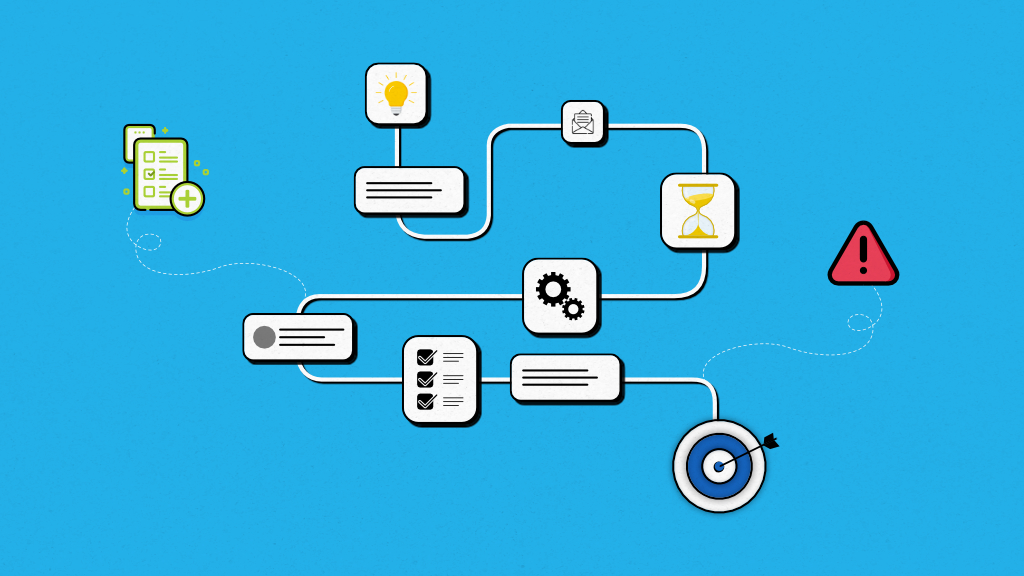The biggest challenge in managing work in the real world is you cannot plan for everything. Certain tasks and projects need to be managed on the fly. These uncertain and unplanned work packages are known as ad hoc projects.
Depending on the magnitude of the work, it can be classified into a task or project. However, irrespective of the nature, the impact of these work packages is more or less similar—it disrupts the current workflow, delays existing projects, and makes it difficult to keep track of the resources (financial, time, and human)—though the severity varies.
I have been down the line many times in my career. Being at the center of marketing a project management software for a decade, I have gained some wisdom on the concepts of project management that can be applied to handle ad hoc projects.
In this post, we will look at what exactly is an ad hoc project, how it can impact the workflow, and some practical ways to manage ad hoc projects.
What are ad hoc projects?
Ad hoc projects are unplanned work requests that are important and require immediate attention. There is not much a project manager can do with these requests. Willingly or unwillingly, the manager has to cater to and work on the requests.
For example, last-minute changes proposed by a client in a blog require immediate editing before publishing or an urgent request to fix a security vulnerability in software developed by your team. These requests cannot be avoided or ignored.
Like this, there are hundreds of scenarios that require immediate attention. All of these work packages or requests can be defined as ad hoc projects.
However, if you want to know the exact meaning or context of the word, “ad hoc”, ad hoc in Latin literally means “for this,” and in English, it describes anything that can be thought of as existing “for this purpose only.”
In the context of work management, ad hoc processes are defined as informal, unstructured, and improvised ways of working that are created on the fly to address a specific situation or problem. These processes are not standardized, documented, and repeatable. These are associated with Capability Maturity Model Integration (CMMI). It is a process improvement framework that helps organizations improve their performance.
CMMI Level 1 represents organizations where work gets done in an ad hoc and chaotic manner with unpredictable, poorly controlled, and reactive processes.
Similarly, ad hoc projects are unplanned, unpredictable, and require immediate attention.
Challenges of ad hoc projects for organization and teams

Ad hoc projects pose serious challenges for organizations and individuals. Here is the mention of the key challenges:
1. Disruption of the existing workflow
The biggest challenge posed by ad hoc projects is the disruption of the existing workflow. This is because team members have to shift from their currently planned tasks to new work requests. This leads to delays in the existing projects and disruption of organizational planned workflow. If this happens frequently, these disruptions can even derail the achievement of the strategic objectives.
2. Missed deadlines
Ad hoc requests hit the projects in progress first because resources are already planned. When these resources have to work on other immediate tasks, it leads to delays and missed deadlines of already allocated tasks.
For example, a software team working on a new feature might have to drop everything to fix a critical bug. This leads to a delay in the feature release of the currently active project.
This can lead to a huge backlog of work and impact the relationship with project stakeholders.
3. Poor tracking and utilization of resources
Another big trouble with ad hoc projects is that they consume time, budget, and resources that aren’t allocated in advance. It poses a series of challenges in tracking and effective utilization of resources. This is because resources have to move from one project to another. This reduces efficiency and makes it difficult to track the resource utilization of projects, leading to poor management of the company’s resources.
4. Reduced quality of work
Ad hoc projects reduce the quality of work. This is because ad hoc projects need to be managed on the fly, with little time to plan or document processes.
Without sufficient planning and standardized processes leads to inconsistent outcomes, as different team members may approach the same problem in different ways. Thus, results may vary in quality. It leads to potential damage to the organization’s reputation if quality is inconsistent.
For example, a marketing team handling last-minute campaign requests might produce varying levels of quality depending on who is available to work on it.
5. Team members’ burnout
Ad hoc projects often require quick turnarounds. Thus, many times employees have to work long hours. If it happens frequently, employees feel like they’re always in “crisis mode” because there is no structured process of project approval. This makes project teams feel overwhelmed and over time leads to burnout, decreased morale, and higher stress.
Not just that, ad hoc projects often lack clear metrics or KPIs due to a lack of time and planning. This makes it hard to evaluate project success. Teams may complete the task but have no way to evaluate success and know if it was truly effective.
Examples of ad hoc projects
Example 1: A critical bug is discovered in a software product just before launch. The development team must drop their planned work to fix the issue immediately.
Example 2: A company faces a sudden PR crisis due to a negative social media post. The marketing team must create and execute a damage control campaign within hours.
Example 3: A last-minute request to organize a corporate event for a high-profile client. The event team must quickly arrange venues, catering, and logistics.
How to manage ad hoc projects?

There are certain steps you can take to manage ad hoc projects. Have a look at some of the ways to manage ad hoc projects.
1. Analyze the impact and prioritize the projects
The first step in dealing with ad hoc projects is to analyze the impact of the project on the business. It is because you know that you have to shift the resources from one project to another. So, you need to choose which project should take the hit and the priority. Make sure the project with less importance and impact is given the secondary priority.
To do so, you can perform the impact analysis. Here is what you need to do:
Step 1: Establish the criteria for the impact analysis of projects.
Common criteria might include:
- Strategic alignment: Does the project align with your organization’s goals, objectives, and priorities?
- Urgency: How quickly does the project need to be addressed?
- Impact: How does the project impact business?
- Risk: What are the potential risks of doing or not doing the project?
- Resource requirements: What resources (time, budget, people) are needed?
- Return on investment (ROI): What value will the project deliver?
- Dependencies: Does the project affect other ongoing projects?
Step 2: Gather data about each ad hoc project to evaluate it against your criteria.
This might include:
- Project objectives: What is the goal of the project?
- Potential outcomes: What are the expected benefits or consequences?
- Timeline: How urgent is the project?
Collect as much information as you can to evaluate and compare projects appropriately.
Learn how to write project objectives using SMART framework!
Step 3: Score each project against the criteria to evaluate each project’s impact.
Use a Weighted Scoring Model to evaluate, compare, and prioritize projects. Here’s what you need to do:
- Assign a weight to each criterion based on its importance. For example, ‘Strategic alignment’ takes 30%, ‘Urgency’ takes 20%, ‘Stakeholder impact’ contributes to 20%, etc.
- Score each project on a scale (e.g., 1-5) for each criterion.
- Multiply the score by the weight and sum the results to get a total score for each project.
Example:
| Criterion | Weightage | Project A Score | Project B Score |
| Strategic alignment | 30% | 4 (4 x 30% = 1.2) | 3 (3 x 30% = 0.9) |
| Urgency | 20% | 5 (5 x 20% = 1.0) | 4 (4 x 20% = 0.8) |
| Stakeholder impact | 20% | 3 (3 x 20% = 0.6) | 5 (5 x 20% = 1.0) |
| Resource Needs | 15% | 2 (2 x 15% = 0.3) | 3 (3 x 15% = 0.45) |
| Risk | 15% | 4 (4 x 15% = 0.6) | 2 (2 x 15% = 0.3) |
| Total | 100% | 3.7 | 3.45 |
In this example, Project A has a higher priority and value than Project B.
You can also take into account the dependencies to evaluate how each project interacts with other ongoing work. It helps determine the project value in context with other projects, identify projects with overall higher value, and choose the right project.
Step 4: Based on the impact analysis, choose a project and allocate resources.
Choose high-value and realistic projects that align with your organization’s goals. Create a project management plan and allocate resources.
If there are multiple projects, you can also use prioritization frameworks like the Eisenhower matrix. It categorizes all the projects into four quadrants based on urgency and importance and suggests action for the project in each quadrant:
- Urgent & Important: Do these immediately.
- Important but Not Urgent: Schedule these for later.
- Urgent but Not Important: Delegate these if possible.
- Not Urgent & Not Important: Ignore these.
Step 5: Communicate the rationale behind decisions to stakeholders for buy-in.
Once you have prioritized the projects, share the decision with stakeholders and explain the rationale behind the decision. This enhanced transparency helps you secure buy-in from stakeholders. Execute the project after approval from stakeholders.
Read more: 11 Best project planning tools for project management in 2025
2. Clearly define the scope and role of the teams
Working on ad hoc projects does not mean acting immediately without thinking. You can still apply project management to it. I agree that all the practices of project management cannot be followed in a crisis, but you can use some standard practices that help you better manage the project.
For example, after the impact analysis of the project, you can clearly define the scope of the project and objectives to achieve, create a project management plan, and define the roles and responsibilities of the team members.
This planning phase of the project is going to be the most challenging because you need to shift the resources from existing projects to a new ad hoc project. To do so, you need clarity on the current utilization and allocation of the resources.
If you are manually tracking the project on the spreadsheets or notes, you might have to do a little extra brainwork to analyze the resource allocation. I recommend using ProofHub to clearly see who is working on what and how much workload & what type of projects are on someone’s plate.
Make sure the best resources are on the most valuable projects. There are certain things you can do:
- Find out the underutilized resources
- Find out what your best resources are working on
- Identify the resources who can better handle the multiple projects and varying workloads, and have experience in similar kinds of projects
This makes sure you make the most out of the existing resources and existing projects have the least impact.
3. Document the project and formalize the project
Ad hoc projects take effort and resources. It is common for organizations and managers not to document and formalize ad hoc projects within a business. Once in a while, it works too for small tasks. However, it creates an issue when there is too much work to do for some people.
Often, the biggest trouble is that others do not know who is working on other projects. Therefore, it is important to document these projects to formalize their existence.
Create a document outlining the parameters of the project and then make this project visible within the business, allowing everyone to see what each other is working on.
The best way to do so is to use project management software. It helps you document the project, validate its existence, and make it easy to track the project in order to evaluate its performance.
4. Formalize the project approval process
Ad hoc project management is not only about reactive measures. There is still a lot you can do for the future.
For example, if ad hoc projects are the norm in your organization, it means it is high time to formalize the project approval process.
Many companies have streamlined workflow to approve new work requests. You can create an approval workflow for your organization, and assign roles and responsibilities at different stages of the workflow to approve or reject projects. This ensures transparency, helps you secure the necessary resources, makes informed decisions aligned with strategic objectives, and brings standardization into business processes. It also helps project team members get a better understanding of expectations and workload.
5. Allocate some time and resources for unexpected tasks
This is something very subjective and varies from organization to organization. Allocate the buffer time and resources to cater to ad hoc projects. This is going to be the most challenging thing as you do not know when to expect ad hoc projects. However, you can use past data and trends to make predictions and find better ways to deal with ad hoc projects.
The extent of the buffer both in terms of time and funds is decided by the organization. It can be anything between 5-20%. The essence is that some kind of buffer is better than no buffer at all.
Read more: 28 Project management skills a project manager must have
Importance of tracking ad hoc projects
Tracking ad hoc projects has many benefits. Have a look at some of them.
- Make it easy to allocate resources. It includes finances, human, and technology resources.
- Accurate tracking also keeps account of how resources are utilized. It helps in decision-making.
- Help you manage human resources because you exactly know who is working on what and when someone is available.
- Make it easy to report to the stakeholders and explain the rationale behind the project-related decision-making.
- Predict and forecast the demand and reserve the contingency reserve to deal with uncertainties.
Tools to manage ad hoc projects: Manage projects with ProofHub

Project management software is the best way to manage projects and entertain ad hoc work requests. Here is a brief explanation of how all-in-one project management and team collaboration software like ProofHub helps you manage ad hoc projects:
- Enhanced visualization of all the projects: ProofHub brings all the projects and their corresponding tasks to one place. You can visualize all the projects from multiple angles with Board, Table, and Calendar views. This makes it easy to keep track of all the projects, reschedule projects, and reallocate resources to accommodate ad hoc projects.
- Centralized task management: ProofHub comes with powerful task management capabilities. You can clearly see who is working on what. With resource utilization reports, you can find out the under or over-utilized resources. Based on the analysis, you can allocate the tasks of ad hoc projects to the resources.
- Advanced planning of the projects: ProofHub comes with powerful in-built Gantt chart software. It allows you to identify the project dependencies, visualize the impact of the delay on the project with a critical path method, and set project constraints. Thus, you can clearly define for what time resources are free or utilized.
- Streamlined workflow of ad hoc projects: ProofHub allows you to build a custom workflow for every project. Thus, you can streamline the approval process of the ad hoc projects to minimize the surprises. With defined standard processes and the right people at the right time for approval, you can better plan for ad hoc projects. This also documents every ad hoc request and validates the existence of ad hoc projects. With the help of project reports, you can better analyze the projects and make improvements in the future.
- Facilitate collaboration in real-time: ProofHub provides a suite of collaboration tools such as discussions, chats, notes, task comments, and announcements to cater to various project collaboration needs. For example, you can use project discussion to clarify each individual’s roles and responsibilities in the project. The platform allows you to share digital files in the discussion for references. Similarly, you can use chat to communicate with team members in real time. All the features are designed to make work collaboration easy and effective.
FAQs:
What is an ad hoc workload?
An ad hoc workload refers to unpredictable or unplanned tasks that arise suddenly, requiring immediate attention. These tasks are not part of routine operations but are essential for addressing urgent needs.
What is ad hoc project management?
Ad hoc project management involves handling spontaneous, unstructured projects with no predefined process. It requires flexibility, quick decision-making, and adaptability to meet unexpected challenges efficiently.
How can I balance ad hoc projects with ongoing responsibilities?
Prioritize tasks, allocate time for unexpected work, and use task management tools. Communicate with your team, delegate when possible, and stay flexible to adapt without compromising long-term goals.
What is an ad hoc manager?
An ad hoc manager is someone who takes on temporary leadership roles for specific, unplanned projects. They coordinate resources, manage teams, and ensure the project’s completion without being in a permanent managerial position.
How can I learn to become better at managing ad hoc projects?
Develop problem-solving, time management, and decision-making skills. Use agile methodologies, stay organized with digital tools, and practice adaptability by handling unexpected challenges effectively.
What does ad hoc stand for?
“Ad hoc” is Latin for “for this purpose.” It refers to something created or arranged spontaneously to address a specific need or situation.
How to manage ad hoc tasks?
Assess urgency, set priorities, allocate resources efficiently, and track progress. Use task management tools and stay flexible to handle shifting demands while maintaining productivity.

